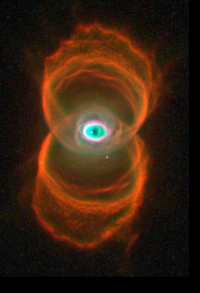- Hourglass Nebula
-
Hourglass Nebula 
Hubble Space Telescope image of the Hourglass NebulaObservation data
(Epoch J2000)Right ascension 13h 39m 35.116s[1] Declination -67° 22′ 51.45″[1] Distance 8 kly (2.5 kpc)[citation needed] Apparent magnitude (V) 13.0[1] Constellation Musca Physical characteristics Radius - Absolute magnitude (V) - Notable features - Other designations ESO 97-1,[1]
PN MyCn 18[1]
Engraved Hourglass Nebula,[1]
Etched Hourglass Nebula,[1]See also: Planetary nebula, Lists of nebulae The Engraved Hourglass Nebula (also known as MyCn 18) is a young planetary nebula situated in the southern constellation Musca about 8,000 light-years away from Earth. It was discovered by Annie Jump Cannon and Margaret W. Mayall during their work on an extended Henry Draper Catalogue (the catalogue was built between 1918 and 1924). At the time, it was designated simply as a small faint planetary nebula. Much improved telescopes and imaging techniques allowed the hourglass shape of the nebula to be discovered by Raghvendra Sahai and John Trauger of the Jet Propulsion Laboratory on January 18, 1996. It is conjectured that MyCn 18's hourglass shape is produced by the expansion of a fast stellar wind within a slowly expanding cloud which is denser near its equator than its poles.
The Hourglass Nebula was photographed by the Wide Field and Planetary Camera 2 of the Hubble Space Telescope.
A less-famous "Hourglass Nebula" is located inside the Lagoon Nebula.
Hourglass Nebula in popular culture
- The Hourglass Nebula was featured on the cover of the April 1997 issue of National Geographic. The nebula’s unique appearance led the magazine’s editors to comment, “Astronomers looked 8,000 light-years into the cosmos with the Hubble Space Telescope, and it seemed that the eye of God was staring back.”
- The Hourglass Nebula also serves as the front cover for Pearl Jam's 2000 album Binaural.
- The Hourglass Nebula appears in the popular game, Final Doom.
- The Hourglass Nebula appears on a poster in the CERN laboratory in the film Angels & Demons.
- The Hourglass Nebula appears extensively, and is used as a major plot point in the 2002 animated series Space Pirate Captain Herlock: The Endless Odyssey.
- The Hourglass Nebula appears in the video game titled Mass Effect 2 as one of the clusters that can be visited for missions.
- The Hourglass Effect is a 2008 album by the British band Shadowkeep.
See also
References
- STScI. Hubble Finds an Hourglass Nebula around a Dying Star. Press release: Space Telescope Science Institute. January 16, 1996.
- ^ a b c d e f g "SIMBAD Astronomical Database". Results for PN MyCn 18. http://simbad.u-strasbg.fr/Simbad. Retrieved 2006-12-22.
Coordinates:
 13h 39m 35.12s, −67° 22′ 51.45″
13h 39m 35.12s, −67° 22′ 51.45″Stars Bayer Nearby Other HD 111232 (b)Other objects Hourglass Nebula · NGC 4833Categories:- Planetary nebulae
- Musca constellation
Wikimedia Foundation. 2010.
